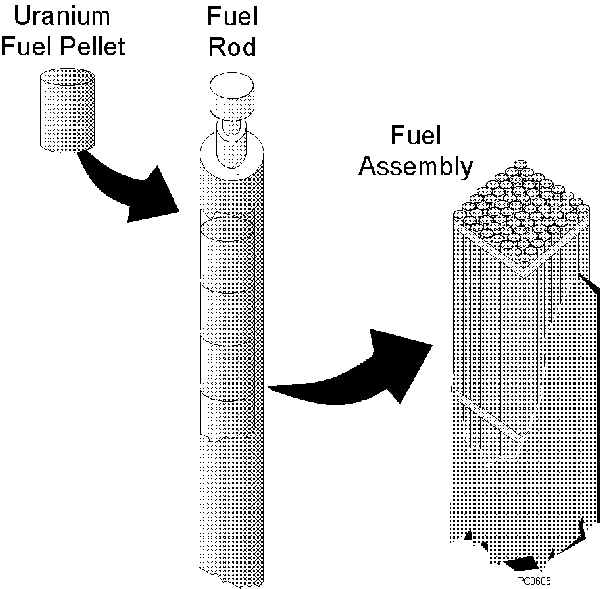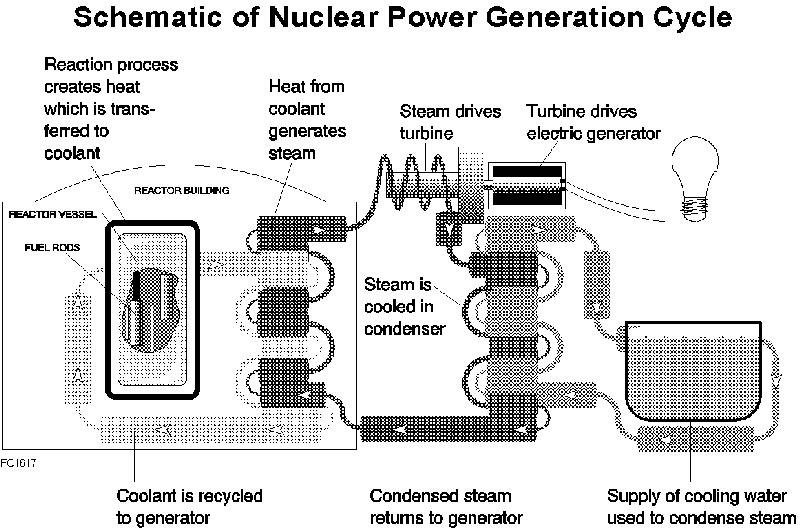
In December of 1957, history was made when Pennsylvania's Shippingport nuclear reactor became the first commercial power plant to generate electricity by harnessing the energy released by nuclear fission. More than 100 commercial nuclear power plants have since been built in the United States and about 20 percent of the nation's electricity comes from nuclear power. In some regions of the country over 50 percent of the electricity is produced from nuclear power.

Nuclear power allows utility companies to keep up with the ever increasing demands for electricity. Like other industrial plants, nuclear power stations produce waste. The primary waste by-product from a nuclear reactor is used or "spent" nuclear fuel assemblies.
What Does Spent Nuclear Fuel Look Like?
Nuclear fuel consists of small, ceramic-like pellets of enriched uranium, slightly larger than pencil erasers. These small pellets produce a tremendous amount of energy when used in a nuclear power plant. For example, one pellet contains the energy equivalent to almost one ton of coal. The pellets are stacked end-to-end and sealed in strong metal tubes 3.5-4.5 meters (12-15 feet) long. Each small pellet is capable of producing tremendous amounts of energy. For example, one pellet contains the energy equivalent to almost one ton of coal. The tubes containing the uranium pellets are bundled together in groups of about 200 to form nuclear fuel assemblies. These fuel assemblies are placed inside a nuclear reactor where the nuclear fission process takes place. Fission is a controlled chain reaction, where atoms split, releasing energy and heat. The heat is used to generate steam and produce electricity until the fuel is spent, or no longer efficient in generating heat.
Approximately every 18 months, about a third of a reactor's fuel is removed and replaced with new, more efficient fuel. Radioactive materials remain inside the sealed tubes of spent nuclear fuel assemblies. Because the fuel assemblies emit radiation, they must be isolated from the environment for thousands of years while the radiation decreases to acceptable levels already found in nature. This process happens naturally over time.
Temporary Storage
After spent nuclear fuel assemblies are removed from a reactor, they are stored at the reactor site in specially treated water pools lined with concrete and steel. Water not only cools the spent nuclear fuel but acts as a natural barrier to shield workers from radiation. Although nuclear power plants in the United States store their spent nuclear fuel this way, it is not intended to be a permanent storage solution.
When additional storage space is needed, utilities have elected to use dry storage systems. This method of storage involves heavy concrete or steel containers, called dry casks, placed on a concrete pad or in a concrete bunker above-ground at the reactor site. Like pool storage, dry storage has been proven safe but is not intended to be a permanent solution for waste disposal.
As a part of the Department of Energy, the Office of Civilian Radioactive Waste Management has been given the responsibility by Congress to plan, construct, and manage a national system for the disposal of spent nuclear fuel and high-level radioactive waste. Congress also provided special funding for the program through the Nuclear Waste Fund. Utilities and rate-payers who benefit from nuclear energy, rather than the general taxpayer, contribute to the fund through their utility bills.
A Permanent Solution
Spent nuclear fuel and high-level radioactive waste will eventually be disposed of in an underground repository. The repository will be built deep beneath the earth's surface and will be designed to contain high-level radioactive material for up to 10,000 years. Certain "engineered barriers" will be incorporated into the design to complement natural barriers and further isolate radiation. Congress has directed the Department of Energy to examine Yucca Mountain, Nevada, and study the area's suitability for a repository. These studies are known as site characterization.
Volume Of Spent Nuclear Fuel
Through 1999, civilian nuclear reactors had produced more than 40,000 metric tons of spent nuclear fuel, about enough to cover one football field four yards deep. The nation's inventory of spent nuclear fuel will reach 62,000 metric tons by the year 2010. This is not a large amount in comparison with the millions of tons of hazardous waste produced each year in the United States. But because spent nuclear fuel is highly radioactive, it requires special measures of protection.
